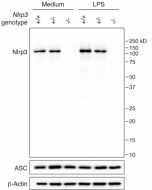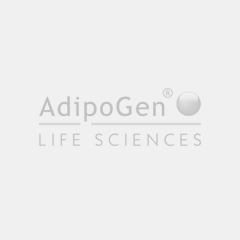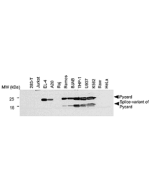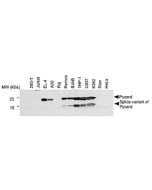Cookie Policy: This site uses cookies to improve your experience. You can find out more about our use of cookies in our Privacy Policy. By continuing to browse this site you agree to our use of cookies.
AdipoGen Life Sciences
anti-NLRP6 (mouse), pAb (IN121)
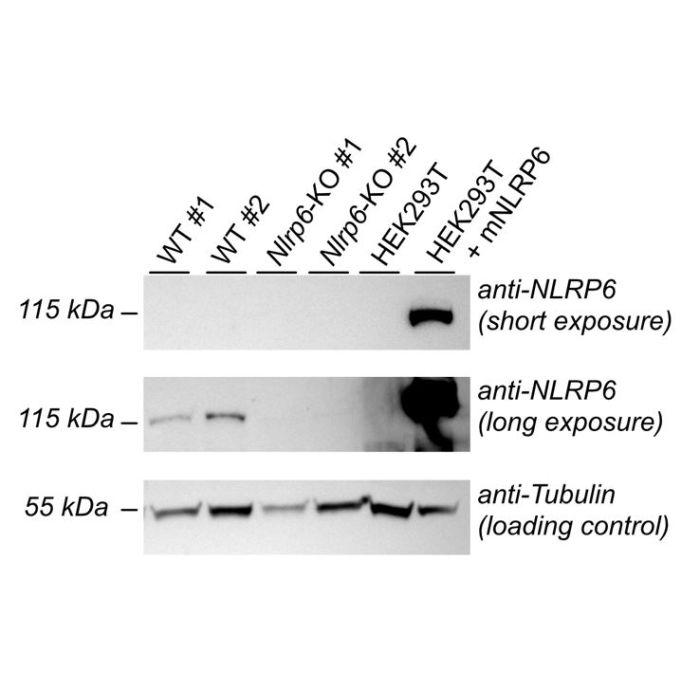
Method: Cell extracts (about 30µg) isolated from intestinal organoids of WT and NLRP6-KO mice, or from HEK293T cells and HEK293T cells transfected with a plasmid encoding the full-length mouse NLRP6 are separated by SDS-PAGE under reducing conditions, transferred to nitrocellulose and incubated with the NLRP6 (mouse), pAb (IN121) (1µg/ml). After incubation with anti-rabbit HRP conjugated antibody, proteins are visualized by ECL. Short exposure and long exposure are shown. A loading control blot is also shown using the antibody anti-β-Tubulin, mAb (rec.) (S11B) (Prod. No. AG-27B-0008). Picture Courtesy of Dr. Alexandra Bögli, Petr Broz lab, University of Lausanne, Switzerland.
Method: Cell extracts (about 30µg) isolated from different tissues of WT and NLRP6-KO mice as indicated are separated by SDS-PAGE under reducing conditions, transferred to nitrocellulose and incubated with the NLRP6 (mouse), pAb (IN121) (1µg/ml). After incubation with anti-rabbit HRP conjugated antibody, proteins are visualized by ECL. A loading control blot is also shown using the antibody anti-β-Tubulin, mAb (rec.) (S11B) (Prod. No. AG-27B-0008). Picture Courtesy of Dr. Alexandra Bögli, Petr Broz lab, University of Lausanne, Switzerland.
| Product Details | |
|---|---|
| Synonyms | NOD-like Receptor Family Pyrin Domain-containing 6; NACHT, LRR and PYD Domains-containing Protein 6; Angiotensin II/Vasopressin Receptor; PYRIN-containing APAF1-like Protein 5-like |
| Product Type | Polyclonal Antibody |
| Properties | |
| Source/Host | Rabbit |
| Immunogen/Antigen | Synthetic peptide corresponding to a 15aa sequence within the NACHT domain of mouse NLRP6. |
| Application |
Western Blot: (1:1'000) |
| Crossreactivity | Mouse |
| Specificity |
Recognizes mouse NLRP6 by Western blot. |
| Purity | ≥95% (SDS-PAGE) |
| Purity Detail | Epitope-affinity purified. |
| Concentration | 1mg/ml |
| Formulation | Liquid. In PBS containing 0.02% Proclin 300, 10% Glycerol. |
| Isotype Negative Control | |
| Accession Number | Q91WS2 |
| Shipping and Handling | |
| Shipping | BLUE ICE |
| Short Term Storage | +4°C |
| Long Term Storage | -20°C |
| Handling Advice |
After opening, prepare aliquots and store at -20°C. Avoid freeze/thaw cycles. |
| Use/Stability | Stable for at least 1 year after receipt when stored at -20°C. |
| Documents | |
| Product Specification Sheet | |
| Datasheet |
 Download PDF Download PDF |
NOD-like receptor family pyrin domain containing 6 (NLRP6), a member of the NOD-like receptor (NLR) family, migrating at 100 kDa in western blot, acts as a cytosolic innate immune sensor that recognizes microbe-associated molecular patterns. NLRP6 recruits the adaptor apoptosis-associated speck-like protein (ASC) and the inflammatory caspase-1 or caspase-11 to form an inflammasome, which mediates the maturation and secretion of the pro-inflammatory cytokines IL-18 and IL-1β. In intestinal epithelial cells, the NLRP6 inflammasome functions in regulating gut microbiome composition, and goblet cell function and is involved in susceptibility to gastrointestinal inflammatory, infectious and neoplastic diseases. In the gut, Nlrp6 controls microbiota, maintains epithelial integrity, and regulates metabolic diseases to modulate host defense during microbial infections, cancer protection, and regulation of neuroinflammation. Nlrp6 has also been shown to negatively regulate NF-κB signaling in mouse models. In Nlrp6-/- mice models, serum IL-18 levels are reduced under steady-state conditions and after dextran sulfate sodium (DSS)-induced colitis. The Nlrp6 inflammasome is activated during bacterial infections and the LTA (lipoteichoic acid) from Listeria binds Nlrp6 and activates the Nlrp6 inflammasome via ASC to regulate host defense during Gram-positive bacterial infection. Nlrp6 activates both caspase-1 and caspase-11.






